Ten years of the bundler
Ten years of the bundler
J. Larson, one of the contemporary Jaynes--Cummings experts, does not make much drama about it but gives an accurate description in his textbook, covering both the Jaynes--Cummings and Mollow aspects, which is a subtle point:

In contrast, González Tudela et al.[1] in their review on light-matter interactions in quantum photonic devices, make uninformed statements, as if the bundler (Ref. 103) is an incremental technological improvement with better cooperativity:
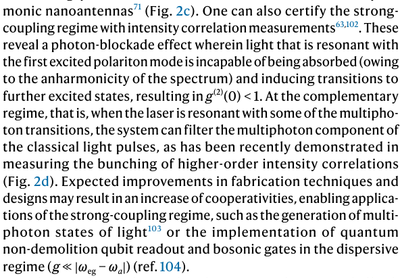
Like most papers, it also cites badly the reference by butchering the name of its first Author as Muñoz C. S. (as it they did not know how to write Spanish names) and, of course, the term "bundle" is not used. I would not quite trust this review for an accurate account of the other papers. It's funny that Larson seems to understand the bundler much better than one of its co-Authors!
The perovskite people seem to like the idea as they see the bundler as a potential beneficiary of their emitters. This is from Raino et al.:[2]

And this is from Cherniukh et al.:[3]
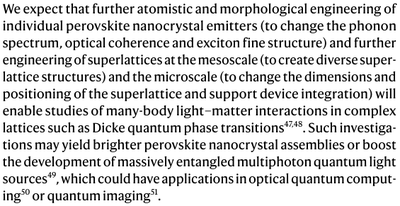
Hamsen et al.[4] comment on direct production under strong driving:

Cygorek et al.[5] quote the bundler as an application of the fluorescence of quantum dots:
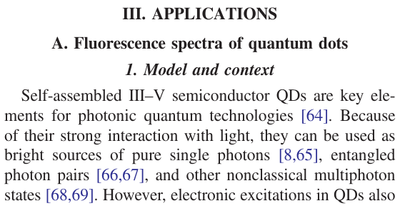
• • Pscherer et al.[6] highlight the bundler and use the term, although as an application of many emitters, which might even be correct, but properly speaking, the application should go with the single-molecule listing:
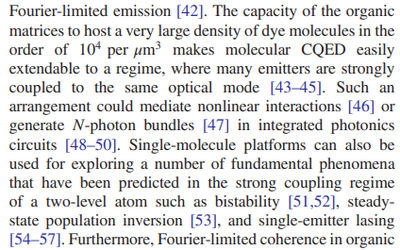
Shi et al.[7] cite the bundler for single photons or photons pairs, which is missing the main point:

• • • Bin et al.[8] port the idea to a different (phonon) platform. They retain the term. I am an author but the main work is from the other group(s). This started a whole activity on bundling with phonons (with a separate branch not quoting the original paper anymore, e.g., in 2022, this paper was more cited [23 times] than the bundler itself [22]):

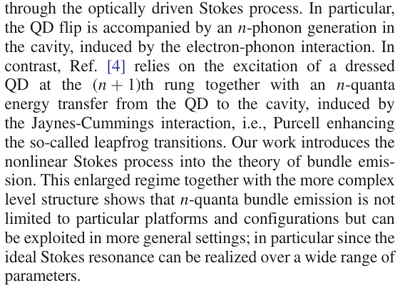
• Müller et al.[9] rightfully point at the future of the results reported in this text. Although we are authors, most of the work (even theoretical) is from the Vuckovic group and we acted more as consultants on this one, in particular due to our role in planting the seminal idea:
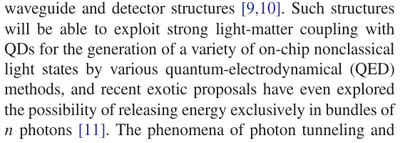
• • • Bin et al.[10] add parity-protection (suppressing even-number bundles) and ultrastrong-coupling dynamics. The bundler paper is cited many times, as various of its concepts, techniques and resulted are used.

• Fischer et al.[12]refers to the temporal structure of the bundle:
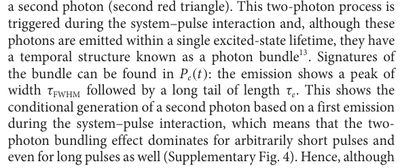
• Boos et al.[13] suggest a time-resolved bundling emission:

Fischer et al.[14] cite the bundler as one of the "multi-photon quantum state generators":

• • • Liu et al.[15], in an already highly-cited paper, although in an obscure journal, study STIRAP technique for high photon-number bundle generation:
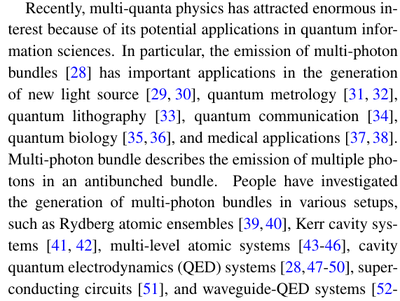
Heindel et al.[16] make a general reference:

Kuruma et al.[17] make the technology required for the bundler in the future:
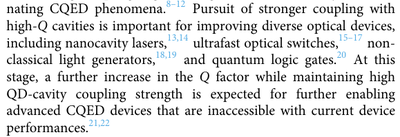
• KockumTemplate:Et al[18] refers to the bundle which could be produced by frequency conversion:
• • • Ma et al.[19] study bundle generations from a Josephson junction:

Krisnanda et al.[20] cites the bundler in connection with NOON states, possibly mistaking this with the superposition ${1\over\sqrt{2}}(\ket{0\mathrm{g}}+\ket{N\mathrm{e}})$:

• • • Yuan et al.[21] bring the scheme to magnons.
• Groiseau et al.[22] comment on (two-photon) bundling opportunities from their THz single-photon source:

Qiang et al.[23] report superbunching from perovskites and link that, maybe hurriedly, to entangled multi-photon quantum light:
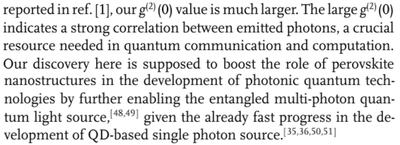
Rundquist et al.[24] limit the bundler to two-photon emission and attribute themselves the potential of generalization:
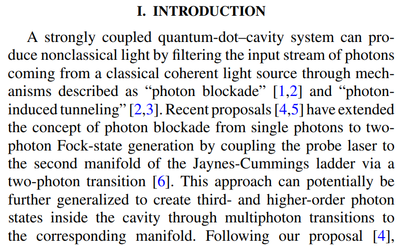
Rivera17a et al.[25] bundle the bundler in a list of references that study two-photon spontaneous emission:

MüllerTemplate:Et al[26], in a sister paper to Ref. [9], cites the bundler for potential applications:
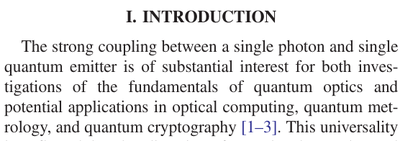
FischerTemplate:Et al[27] again pack up the bundler among multi-photon quantum state generators:

• RiveraTemplate:Et al[28] compare their Fock-laser to the bundler:
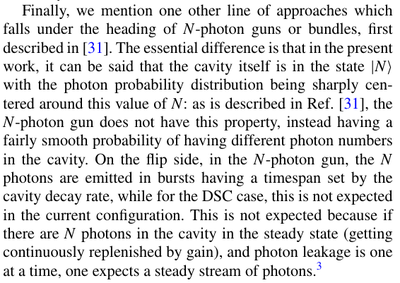
Gu et al.[29] cite the bundler as a general $n$-photon source.

• Nair et al.[30] say that the ultra-strong coupling regime leads to newer possibilities such as the production of output fields in Fock states, suggesting they do not understand the bundling mechanism (that relies neither on ultra-strong coupling nor, which is more subtle, does it produce Fock states):
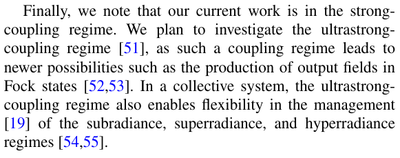
• Pashaei Adl et al.[31] again with perovskites refer to bundles or "bursts"


Groiseau et al.[32] make the incorrect statement that the bundler is (like other multiphoton sources) low-yield. It is CW so one could say it is intrinsically probabilistic in the form we have presented it:

Template:Nguyen23a et al.[33] ...
Template:Sanchezmunoz20b et al.[34] are inspired by the bundler and its derived papers, although they do not use the term "bundle" (interestingly, Kockum does when Sánchez is not an author):


Arlt et al.[35] cite the bundler as the pursuit of probabilistic multiparticle emitter:

Sloan et al.[36] cite the bundler in connection to medical applications:

• • • Deng et al.[37] study phonon-bundles from a trapped ion, and introduces a distinction between Mollow and parametric down conversion:
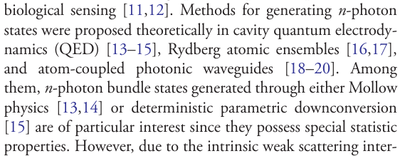
• • • Gou et al.[38]
Chang et al.[39] cites the bundler (without ever using the term "bundle") as a new theoretical proposal using Purcell enhancement on dressed atomic system (not using the term leapfrog either, making the description quite vague and moot) and providing a definition of continuous multiphoton emission.
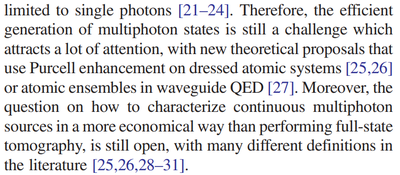

Hendrikson et al.[40] cite the bundler in the context of integrated quantum nonlinear optics:

Rinaldi et al.[41] cite the bundler as an example producing nontrivial statistics. The term bundle is not used for photons, but it is accepted for the optical fibred that are bundled to make a camera though:
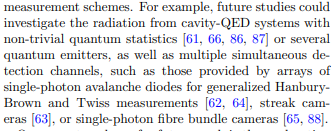
FischerTemplate:Et al[42] identify a regime of low-detuned photon bundling:

References
- ↑ Template:Tudela24a
- ↑ Template:Raino18a
- ↑ Perovskite-type superlattices from lead halide perovskite nanocubes. I. Cherniukh, G. Rainò, T. Stöferle, M. Burian, A. Travesset, D. Naumenko, H. Amenitsch, R. Erni, R. F. Mahrt, M. I. Bodnarchuk and M. V. Kovalenko in Nature 593:535 (2021).
- ↑ Template:Hamsen17a
- ↑ Sublinear Scaling in Non-Markovian Open Quantum Systems Simulations. M. Cygorek, J. Keeling, B. W. Lovett and E. M. Gauger in Phys. Rev. X 14:011010 (2024).
- ↑ Template:Pscherer21a
- ↑ Template:Shi15a
- ↑ $N$-Phonon Bundle Emission via the Stokes Process. Q. Bin, X.-Y Lü, F. P. Laussy, F. Nori and Y. Wu in Phys. Rev. Lett. 124:053601 (2020).
- ↑ 9.0 9.1 Coherent generation of nonclassical light on chip via detuned photon blockade. K. Müller, A. Rundquist, K. A. Fischer, T. Sarmiento, K. G. Lagoudakis, Y. A. Kelaita, C. Sánchez Muñoz, E. del Valle, F. P. Laussy and J. Vučković in Phys. Rev. Lett. 114:233601 (2015).
- ↑ Parity-Symmetry-Protected Multiphoton Bundle Emission. Q. Bin, Y. Wu and X.-Y. Lü in Phys. Rev. Lett. 127:073602 (2021).
- ↑ Template:Loredo19a
- ↑ Signatures of two-photon pulses from a quantum two-level system. K. Fischer, L. Hanschke, J. Wierzbowski, T. Simmet, C. Dory, J. Finley, J. Vučković and K. Müller in Nature Phys. 13:649 (2017).
- ↑ Signatures of Dynamically Dressed States. K. Boos, S. K. Kim, T. Bracht, F. Sbresny, J. M. Kaspari, M. Cygorek, H. Riedl, F. W. Bopp, W. Rauhaus, C. Calcagno, J. J. Finley, D. E. Reiter and K. Müller in Phys. Rev. Lett. 132:053602 (2024).
- ↑ Scattering into one-dimensional waveguides from a coherently-driven quantum-optical system. K. A. Fischer, R. Trivedi, V. Ramasesh, I. Siddiqi and J. Vučković in Quantum 2:69 (2018).
- ↑ Template:Liu22a
- ↑ Template:Heindel17a
- ↑ Template:Kuruma20a
- ↑ Template:Kockum17a
- ↑ Template:Ma21a
- ↑ Template:Krisnanda21a
- ↑ Template:Yuan23a
- ↑ Single-Photon Source Over the Terahertz Regime. C. Groiseau, A. I. Fernández-Domínguez, D. Martín-Cano and C. S. Muñoz in Phys. Rev. X Quantum 5:010312 (2024).
- ↑ Template:Qiang23a
- ↑ Template:Rundquist14a
- ↑ Template:Rivera17a
- ↑ Template:Muller15b
- ↑ Pulsed Rabi oscillations in quantum two-level systems: beyond the area theorem. K. A. Fischer, L. Hanschke, M. Kremser, J. J. Finley, K. Müller and J. Vučković in Quantum Sci. Technol. 3:014006 (2017).
- ↑ Template:Rivera23a
- ↑ Quantum experiments and hypergraphs: Multiphoton sources for quantum interference, quantum computation and quantum entanglement. X. Gu, L. Chen and M. Krenn in Phys. Rev. A 101:033816 (2020).
- ↑ Template:Nair20a
- ↑ Template:Pashaeiadl23a
- ↑ Proposal for a Deterministic Single-Atom Source of Quasisuperradiant $N$-Photon Pulses. C. Groiseau, A. E. Ellio, d. S. J. Mass and d. S. Parkins in Phys. Rev. Lett. 127:033602 (2021).
- ↑ Template:Nguyen23a
- ↑ Template:Sanchezmunoz20b
- ↑ Arlt et al. arXiv:2210.09981
- ↑ Template:Sloan21a
- ↑ Motional $n$-phonon bundle states of a trapped atom with clock transitions. Y. Deng, T. Shi and S. Yi in Phot. Res. 9:1289 (2021).
- ↑ Antibunched two-mode two-photon bundles via atomic coherence. C. Gou, X. Hu and F. Wang in Phys. Rev. A 106:063718 (2022).
- ↑ Deterministic Down-Converter and Continuous Photon-Pair Source within the Bad-Cavity Limit. Y. Chang, A. González-Tudela, C. S. Mu~noz, C. Navarrete-Benlloch and T. Shi in Phys. Rev. Lett. 117:203602 (2016).
- ↑ Template:Hendrickson14a
- ↑ Rinaldi et al. arXiv:2310.02309
- ↑ Self-homodyne measurement of a dynamic Mollow triplet in the solid state. K. A. Fischer, K. Müller, A. Rundquist, T. Sarmiento, A. Y. Piggott, Y. Kelaita, C. Dory, K. G. Lagoudakis and J. Vučković in Nature Phys. 10:163 (2016).